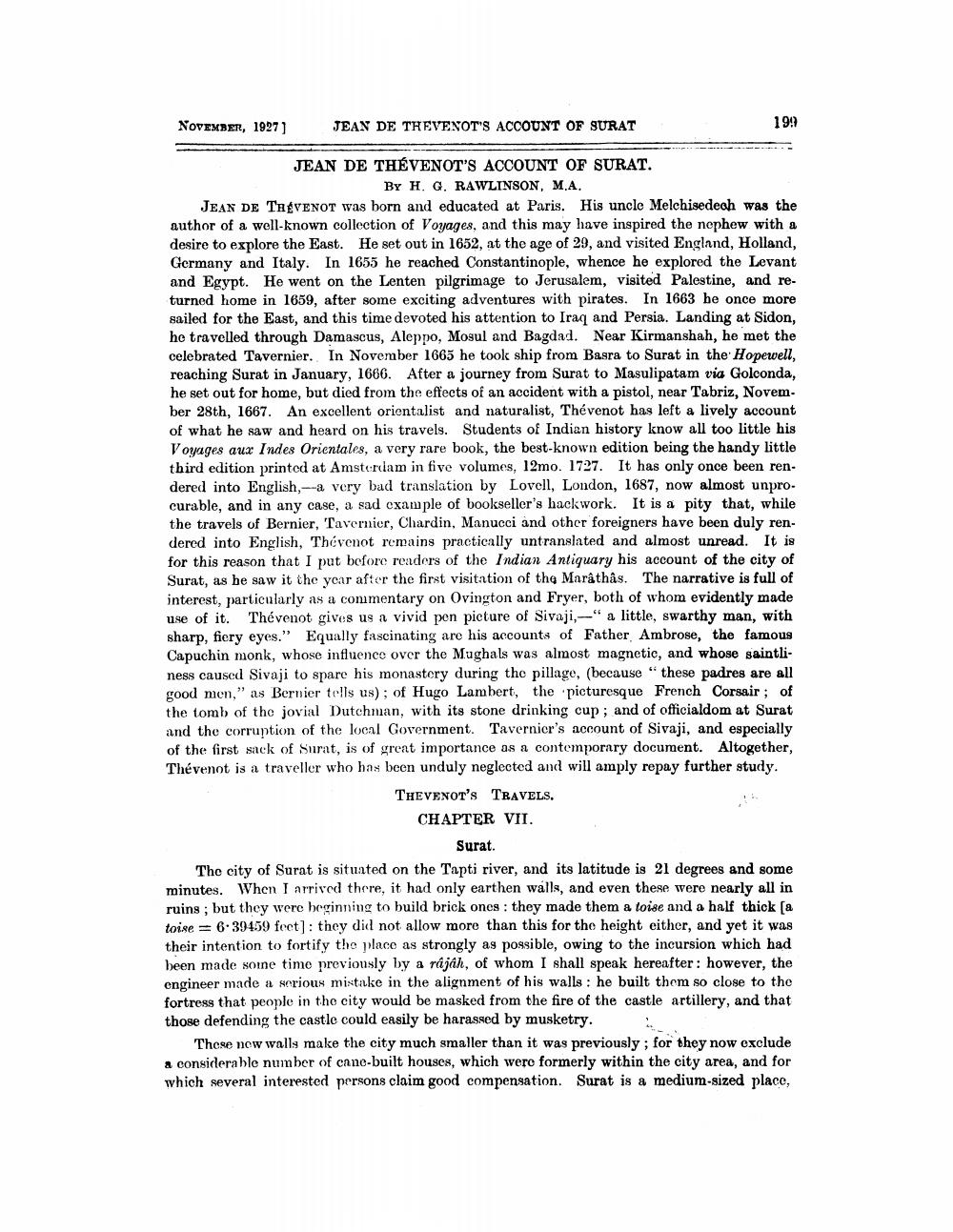________________
NOVEMBER, 1927)
JEAN DE THEVENOT'S ACCOUNT OF SURAT
199
JEAN DE THÉVENOT'S ACCOUNT OF SURAT.
BY H. G. RAWLINSON, M.A. JEAN DE TRØVENOT was born and educated at Paris. His uncle Melchisedech was the author of a well-known collection of Voyages, and this may have inspired the nephew with a desire to explore the East. He set out in 1652, at the age of 29, and visited England, Holland, Germany and Italy. In 1655 he reached Constantinople, whence he explored the Levant and Egypt. He went on the Lenten pilgrimage to Jerusalem, visited Palestine, and returned home in 1659, after some exciting adventures with pirates. In 1663 be once more sailed for the East, and this time devoted his attention to Iraq and Persia. Landing at Sidon, he travelled through Damascus, Aleppo, Mosul and Bagdad. Near Kirmanshah, he met the celebrated Tavernier. In November 1665 he took ship from Basra to Surat in the Hopewell, reaching Surat in January, 1666. After a journey from Surat to Masulipatam via Golconda, he set out for home, but died from the effects of an accident with a pistol, near Tabriz, November 28th, 1667. An excellent orientalist and naturalist, Thévenot has left a lively account of what he saw and heard on his travels. Students of Indian history know all too little his Voyages aux Indes Orientales, a very rare book, the best-known edition being the handy little third edition printed at Amsterdam in five volumes, 12mo. 1727. It has only once been rendered into English,--a very bad translation by Lovell, London, 1687, now almost unprocurable, and in any case, a sad cxample of bookseller's hackwork. It is a pity that, while the travels of Bernier, Tavernier, Chardin, Manucci and other foreigners have been duly rendered into English, Thévenot remains practically untranslated and almost unread. It is for this reason that I put before readers of the Indian Antiquary his account of the city of Surat, as he saw it the year after the first visitation of the Marathas. The narrative is full of interest, particularly as a conimentary on Ovington and Fryer, both of whom evidently made use of it. Thévenot gives us a vivid pen picture of Sivaji.--" a little, swarthy man, with sharp, fiery eyes." Equally fascinating are his accounts of Father, Ambrose, the famous Capuchin monk, whose influence over the Mughals was almost magnetic, and whose saintliness caused Sivaji to spare his monastery during the pillage, (because these padres are all good men," as Bernier tells us); of Hugo Lambert, the picturesque French Corsair ; of the tomb of the jovial Dutchman, with its stone drinking cup; and of officialdom at Surat and the corruption of the local Government. Tavernier's account of Sivaji, and especially of the first sack of Surat, is of great importance as a contemporary document. Altogether, Thévenot is a traveller who has been unduly neglected and will amply repay further study.
THEVENOT'S TRAVELS. CHAPTER VII.
Surat. The city of Surat is situated on the Tapti river, and its latitude is 21 degrees and some minutes. When I arrived there, it had only earthen walls, and even these were nearly all in ruins; but they were beginning to build brick oncs : they made them a toise and a half thick [a toise = 6.39459 foct]: they did not allow more than this for the height either, and yet it was their intention to fortify the place as strongly as possible, owing to the incursion which had been made some time previously by a rájáh, of whom I shall speak hereafter : however, the engineer made a serious mistake in the alignment of his walls: he built them so close to the fortress that people in the city would be masked from the fire of the castle artillery, and that those defending the castle could easily be harassed by musketry.
These new walls make the city much smaller than it was previously; for they now exclude a considerable number of cane-built houses, which were formerly within the city area, and for which several interested persons claim good compensation. Surat is a medium-sized place,




